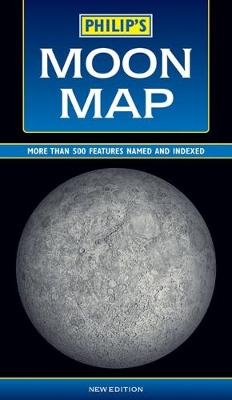
Philip's Moon Map
Seiten
2003
Philip's (Verlag)
978-0-540-06378-9 (ISBN)
Philip's (Verlag)
978-0-540-06378-9 (ISBN)
- Titel ist leider vergriffen;
keine Neuauflage - Artikel merken
A highly detailed large-format map of the near side of the Moon, drawn by Dr John Murray, a lunar expert at the Open University.
Philip's Moon Map is a large-format folded map of the near side of the Moon. It has been specially drawn for Philip's by Dr John Murray, a research lecturer at the Open University, who is an expert on the lunar surface. The map is not only a highly accurate and clear representation of the Moon, but is also a practical guide for lunar observers.More than 500 physical features - craters, seas, mountain ranges, peaks, valleys and rilles (elongated depressions) - are named and indexed, and the landing sites of unmanned and manned spacecraft are also marked. The observer can thus readily identify objects seen through binoculars or a telescope, or select targets for a programme of observation.The chart includes a small map of the far side of the Moon (never visible from the Earth) and is accompanied by a practical guide to lunar observing. This concise and informative text describes the various types of feature to observe, illustrated with drawings and photographs. Tips are given as to the best point in the lunar cycle to observe the most interesting of these features. Guidelines on drawing or photographing the Moon are also included.Colour artworks explain the Moon's orbit, and why its phase (the proportion of the Moon that is visible from Earth) changes during the course of a month. Also explained, with the help of illustrations, are the path of the Moon during the course of the year and why lunar and solar eclipses occur.
Philip's Moon Map is a large-format folded map of the near side of the Moon. It has been specially drawn for Philip's by Dr John Murray, a research lecturer at the Open University, who is an expert on the lunar surface. The map is not only a highly accurate and clear representation of the Moon, but is also a practical guide for lunar observers.More than 500 physical features - craters, seas, mountain ranges, peaks, valleys and rilles (elongated depressions) - are named and indexed, and the landing sites of unmanned and manned spacecraft are also marked. The observer can thus readily identify objects seen through binoculars or a telescope, or select targets for a programme of observation.The chart includes a small map of the far side of the Moon (never visible from the Earth) and is accompanied by a practical guide to lunar observing. This concise and informative text describes the various types of feature to observe, illustrated with drawings and photographs. Tips are given as to the best point in the lunar cycle to observe the most interesting of these features. Guidelines on drawing or photographing the Moon are also included.Colour artworks explain the Moon's orbit, and why its phase (the proportion of the Moon that is visible from Earth) changes during the course of a month. Also explained, with the help of illustrations, are the path of the Moon during the course of the year and why lunar and solar eclipses occur.
Dr John Murray is a lunar expert at the Open University.
| Erscheint lt. Verlag | 19.11.2003 |
|---|---|
| Illustrationen | Dr John Murray |
| Verlagsort | London |
| Sprache | englisch |
| Maße | 136 x 237 mm |
| Gewicht | 95 g |
| Themenwelt | Sachbuch/Ratgeber ► Natur / Technik ► Weltraum / Astronomie |
| Naturwissenschaften ► Physik / Astronomie ► Astronomie / Astrophysik | |
| ISBN-10 | 0-540-06378-9 / 0540063789 |
| ISBN-13 | 978-0-540-06378-9 / 9780540063789 |
| Zustand | Neuware |
| Haben Sie eine Frage zum Produkt? |
Mehr entdecken
aus dem Bereich
aus dem Bereich
die Suche nach der Urkraft des Universums
Buch | Hardcover (2023)
Klett-Cotta (Verlag)
25,00 €
Perspektiven auf die Menschheit
Buch | Hardcover (2024)
Klett-Cotta (Verlag)
25,00 €


